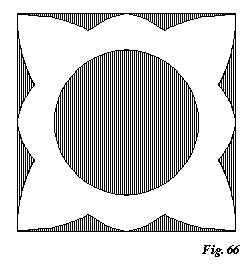384 THE STONES OF VENICE DECORATION
one of the exceptions which it was above noticed that we should sometimes find to the law stated in § 15 above.
§ 42. The lower capital, which is also of the true convex school, exhibits one of the conditions of the spurred type, e of Fig. 22, respecting which one or two points must be noticed.
If we were to take up the plan of the simple spur, represented at e in Fig. 22, p. 140, and treat it, with the salvia leaf, as we did the spur of the base [p. 339], we should have for the head of our capital a plan  like Fig. 66, which is actually that of one of the capitals of the Fondaco de’ Turchi at Venice; with this only difference, that the intermediate curves between the spurs would have been circular: the reason that they are not so, here, is that the decoration, instead of being confined to the spur, is now spread over the whole mass, and contours are therefore given to the intermediate curves which fit them for this ornament; the inside shaded space being the head of the shaft, and the outer, the abacus. The reader has in Fig. 66 a characteristic type of the plans of spurred capitals, generally preferred by the sculptors of the convex school, but treated with infinite variety, the spurs often being cut into animal forms, or the incisions between them multiplied, for richer effect; and in our own Norman capital the type c of Fig. 22 is variously subdivided by incisions on its slope, approximating in general effect to many conditions of the real spurred type e, but totally differing from them in principle.
like Fig. 66, which is actually that of one of the capitals of the Fondaco de’ Turchi at Venice; with this only difference, that the intermediate curves between the spurs would have been circular: the reason that they are not so, here, is that the decoration, instead of being confined to the spur, is now spread over the whole mass, and contours are therefore given to the intermediate curves which fit them for this ornament; the inside shaded space being the head of the shaft, and the outer, the abacus. The reader has in Fig. 66 a characteristic type of the plans of spurred capitals, generally preferred by the sculptors of the convex school, but treated with infinite variety, the spurs often being cut into animal forms, or the incisions between them multiplied, for richer effect; and in our own Norman capital the type c of Fig. 22 is variously subdivided by incisions on its slope, approximating in general effect to many conditions of the real spurred type e, but totally differing from them in principle.
§ 43. The treatment of the spur in the concave school is far more complicated, being borrowed in nearly every case from the original Corinthian. Its plan may be generally represented by Fig. 67. The spur itself is carved into a curling tendril or concave leaf, which supports the projecting
[Version 0.04: March 2008]
